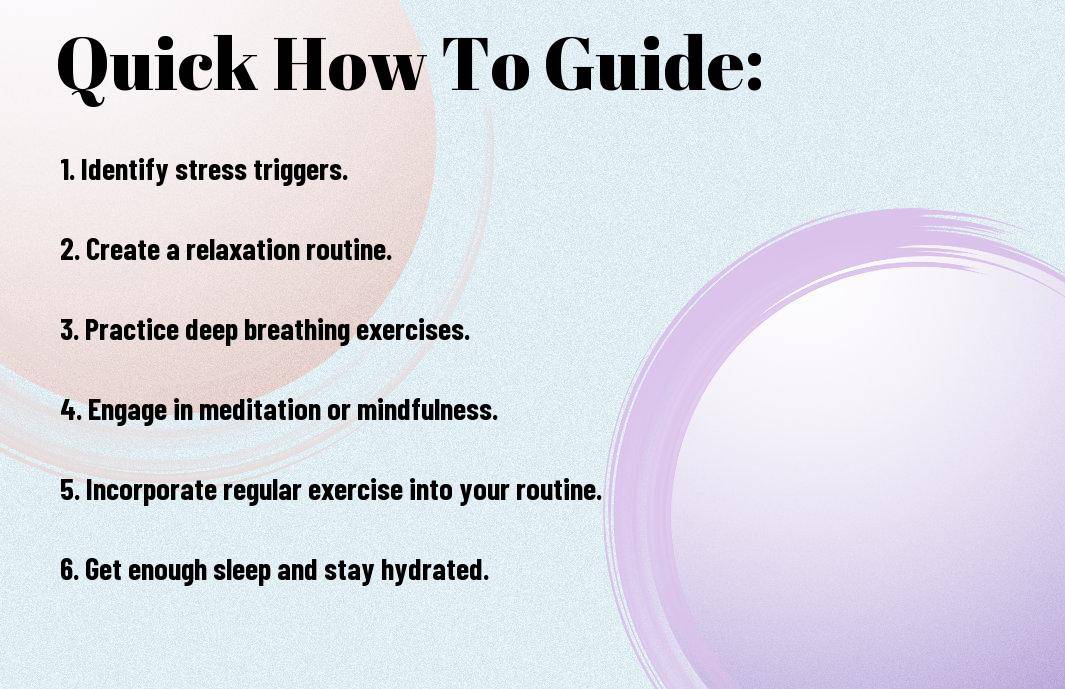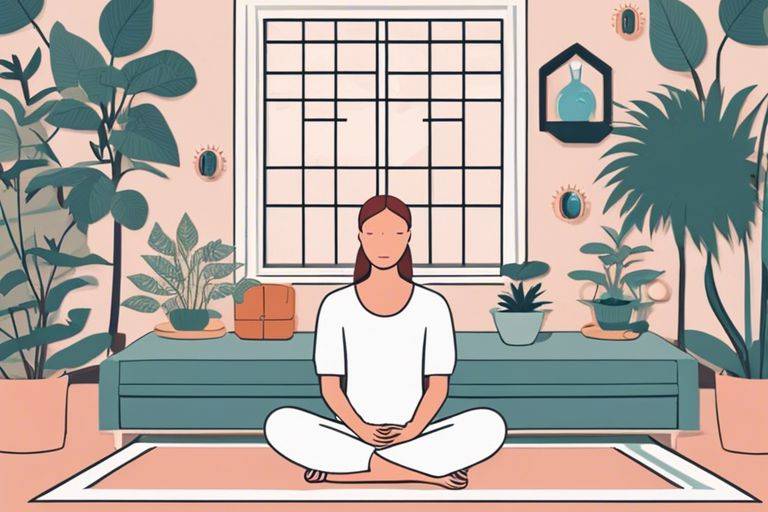You may already know that stress can have a significant impact on your health and well-being. Finding effective ways to manage stress is crucial for maintaining a balanced lifestyle. In this blog post, we will explore how incorporating Atomic Habits into your daily routine can help you effectively manage stress through relaxation techniques. If you want to learn more about Atomic Habits, check out Five Lessons from the Book Atomic Habits You Can Apply Today for additional insights.
Key Takeaways:
- Consistency is key: Establish a regular relaxation routine to effectively manage stress.
- Start small: Begin with short relaxation practices and gradually increase the duration as it becomes a habit.
- Choose techniques that work for you: Experiment with different relaxation techniques to find what helps you destress the most.
- Integrate relaxation into your daily life: Incorporate relaxation practices into your daily schedule to make it a habit.
- Combine relaxation with other habits: Pair relaxation techniques with existing habits to reinforce relaxation habits.
- Practice mindfulness: Bring awareness to the present moment while practicing relaxation techniques to enhance their effectiveness.
- Track your progress: Keep a journal or use an app to monitor your relaxation habits and adjust as needed for optimal stress management.

Laying the Foundation for Stress Management
Identifying Your Stress Triggers
Little do we realize that stress doesn’t always stem from obvious sources. Any small inconvenience or a certain environment can unknowingly trigger stress in our lives. To effectively manage stress, it’s crucial to take the time to identify these triggers. Keep a journal, noting down situations or people that consistently make you feel anxious or overwhelmed. By recognizing your stress triggers, you can manage them more effectively and prevent future episodes.
Creating a Supportive Environment for Change
Little changes in our environment can have a significant impact on our stress levels. One simple way to create a supportive environment for stress management is to declutter your space. A clutter-free area can promote a sense of calm and clarity. Additionally, surround yourself with positive influences such as supportive friends or family members. Their encouragement and understanding can benefit your journey towards managing stress effectively.
Management of stress is not a one-size-fits-all approach. It’s important to tailor your stress management techniques to suit your unique needs and circumstances. By taking small steps to identify triggers, creating a supportive environment, and seeking positive influences, you can build a solid foundation for effective stress management.
How to Build Relaxation into Your Routine
The Role of Consistency in Effective Stress Management
Not incorporating relaxation practices into your daily routine can lead to an accumulation of stress and tension in your mind and body. Consistency is key when it comes to effective stress management because integrating regular moments of relaxation helps to combat the negative effects of stress and promote overall well-being.
Tips for Making Relaxation a Daily Habit
Your daily routine should include dedicated time for relaxation to ensure you are consistently addressing stress in your life. Consider starting your day with meditation or deep breathing exercises to set a calm tone for the hours ahead. This simple practice can help you manage stress more effectively throughout the day.
- Find a relaxation technique that works for you
- Schedule relaxation time into your day
More Information on Tips for Making Relaxation a Daily Habit
Clearly, incorporating relaxation into your daily routine is imperative for managing stress and promoting overall well-being. By making relaxation a daily habit, you are proactively taking steps to reduce the negative impacts of stress on your mind and body, leading to a more balanced and fulfilling life.
- Experiment with different relaxation methods
- Practice self-care regularly
Mindfulness Techniques for Stress Reduction
How to Practice Mindful Breathing
For many people, mindful breathing is a straightforward and effective way to reduce stress and promote relaxation. Even just a few minutes of focusing on your breath can help calm the mind and body. Find a quiet and comfortable place to sit or lie down. Close your eyes and take a few deep breaths. Then, breathe naturally and pay attention to the sensation of each inhale and exhale. Even if your mind wanders, gently guide your focus back to your breath. Consistency is key, so try to practice mindful breathing for a few minutes each day to reap the benefits.
Incorporating Mindfulness into Everyday Activities
To incorporate mindfulness into your daily routine, try to be fully present in each activity you do. Whether you’re washing dishes, walking, or eating a meal, everyday task can become an opportunity for mindfulness. Focus on the sensations, sounds, and smells around you. Even mundane activities can be transformed into moments of peace and relaxation when approached with mindfulness. Slow down and savor each moment for a calmer and more centered state of mind.
The Art of Progressive Muscle Relaxation
Despite the hustle and bustle of modern life, finding moments of peace and relaxation is crucial for our overall well-being. In my recent blog post on Eliminating Anxiety Through the Power of Atomic Habits, I discussed the significance of small habits in managing stress. Among the various relaxation techniques available, Progressive Muscle Relaxation (PMR) stands out for its effectiveness in promoting deep relaxation and reducing tension in the body.
Step-by-Step Guide to Progressive Muscle Relaxation
| Step 1: | Tense and Release |
| Step 2: | Focus on Each Muscle Group |
Clearly, PMR involves systematically tensing and relaxing specific muscle groups in a sequential manner, starting from the toes and moving up to the head. This process helps individuals become more aware of the physical sensations associated with tension and relaxation, ultimately leading to a greater sense of calmness and serenity.
Factors That Enhance the Benefits of Muscle Relaxation
- Consistency: Regular practice of PMR enhances its effectiveness over time.
- Deep Breathing: Combining deep breathing techniques with PMR amplifies the relaxation response.
Assuming a comfortable position and creating a quiet environment are important for maximizing the benefits of Progressive Muscle Relaxation. By incorporating PMR into your daily routine and being consistent with its practice, you can experience a significant reduction in stress and tension. Any effort put into mastering this relaxation technique will undoubtedly yield positive results in promoting overall well-being.
Finding Your Comfort Zone
- Start Slow: Don’t rush the process; allow yourself to fully relax each muscle group.
- Listen to Your Body: Pay attention to areas of tension and focus on releasing that stress.
Muscle relaxation techniques such as PMR offer a simple yet powerful way to unwind and de-stress, making it an invaluable tool in today’s fast-paced world. Embrace the practice with dedication, and you’ll soon reap the benefits of a more relaxed and centered state of being.

Leveraging Visualization and Guided Imagery
Many people find relief from stress through the power of visualization and guided imagery. These techniques involve creating mental images to promote relaxation and reduce anxiety. By engaging your senses in a mental escape, you can transport yourself to a peaceful sanctuary that calms your mind and body.
How to Construct Your Personal Stress-Free Sanctuary
StressFree Creating your personal stress-free sanctuary begins with finding a quiet and comfortable space where you can fully focus on relaxation. Close your eyes and imagine a place that brings you a sense of peace and tranquility. Visualize every detail, from the colors and textures to the sounds and scents present in your sanctuary. Whether it’s a serene beach, a cozy cabin in the mountains, or a lush garden, let your imagination run wild as you build your own stress-free oasis.
Tips for Effective Visualization Practices
Visualization To enhance your visualization practice, incorporate deep breathing techniques, positive affirmations, and progressive muscle relaxation. This multi-sensory approach can deepen your relaxation experience and help you connect more fully with your stress-free sanctuary. Allow yourself to fully immerse in the mental imagery, focusing on the feelings of peace and serenity it brings. This consistent practice can train your mind to respond positively to stress triggers, promoting a sense of calm and well-being.
Creating an Evening Routine to Decompress
The Importance of Unwinding Before Bed
All work and no play can take a toll on your mind and body. It’s crucial to take the time to unwind before bed to release the day’s tension and prepare yourself for a restful night’s sleep. By incorporating relaxation techniques into your evening routine, you can signal to your body that it’s time to shift into a more tranquil state.
How to Design a Soothing Nighttime Ritual
An evening routine can help you detach from the day’s stressors and transition into a state of relaxation. Start by creating a calming environment in your bedroom – dim the lights, play soft music, or light a scented candle to set the mood. Consider incorporating activities that promote relaxation, such as reading a book, practicing gentle yoga, or engaging in deep breathing exercises. Creating a consistent bedtime ritual can signal to your brain that it’s time to wind down, making it easier to fall asleep peacefully.
When designing your nighttime ritual, focus on activities that help you relax and unwind. Disconnect from electronic devices at least an hour before bed to reduce screen time exposure, which can disrupt your sleep. Instead, opt for soothing activities that promote calmness and prepare your mind and body for a restful night ahead.
Managing Stress Through Movement
Establishing a Simple Exercise Routine for Relaxation
Keep it simple when it comes to managing stress through movement. Physical activity is a powerful tool for reducing stress levels. Even just a short walk or a quick workout can help release tension and calm your mind. The key is to find an exercise routine that you enjoy and can easily incorporate into your daily life.
How to Incorporate Stretching and Yoga into Your Stress Relief Plan
You may be surprised at how effective stretching and yoga can be in reducing stress. Assuming you are new to these practices, start with simple poses and stretches that focus on releasing tension in your body. Make it a point to incorporate a few minutes of stretching or yoga into your daily routine, especially during stressful moments. Not only will it help relax your body, but it will also calm your mind and improve your overall well-being.
Relaxation is necessary for managing stress, and movement can be a powerful tool in achieving it. By establishing a simple exercise routine and incorporating stretching or yoga into your stress relief plan, you can take active steps towards a more relaxed and balanced life.
Nourishment and Stress: Eating Habits That Help
After a long day of dealing with stress, it’s important to pay attention to what you eat. Your diet can have a significant impact on your stress levels and overall well-being. By choosing the right foods, you can nourish your body and mind, promoting relaxation and reducing the negative effects of stress.
How to Choose Stress-Reducing Foods
StressReducing foods are those that help to lower stress levels and promote a sense of calm. These foods are often rich in important nutrients like magnesium, which can help to regulate cortisol levels in the body. Consider incorporating foods like leafy green vegetables, nuts, seeds, and whole grains into your diet to support your stress management goals.
Crafting a Meal Plan that Supports Your Stress Management Goals
For effective stress management, it’s necessary to create a meal plan that supports your goals. This includes incorporating a variety of nutrient-dense foods that provide a steady source of energy throughout the day. Planning ahead can help you make healthier choices and avoid reaching for convenience foods that may exacerbate stress levels.
When crafting your meal plan, aim to include a balance of protein, healthy fats, and carbohydrates at each meal. This can help to stabilize blood sugar levels and prevent energy crashes that can contribute to feelings of stress and anxiety. By prioritizing nourishing foods and planning your meals ahead of time, you can create a supportive environment for managing stress and promoting overall well-being.
Tech to the Rescue: Apps and Tools for Relaxation
Unlike traditional methods of stress management, technology offers a new and innovative way to incorporate relaxation techniques into your daily routine. In today’s fast-paced world, it’s crucial to make use of tools that can help us unwind and destress. According to How to Reduce Stress at Work (And Why Overwork Could …, overworking can lead to burnout and decreased productivity, making it crucial to find effective ways to manage stress.
How to Use Technology to Your Advantage for Stress Management
On top of traditional methods like meditation and deep breathing exercises, technology offers a variety of ways to help you manage stress. Apps like Calm and Headspace provide guided meditation sessions that can be easily accessed on your smartphone, allowing you to relax and unwind wherever you are. Additionally, tools like wearable fitness trackers can help you monitor your stress levels and remind you to take breaks when needed, promoting a healthier work-life balance.
Discovering the Best Relaxation Apps on the Market
There’s an abundance of relaxation apps available on the market, each offering unique features to help you unwind and destress. Whether you’re looking for guided meditation, soothing music, or mindfulness exercises, there’s an app out there to suit your needs. Some apps even offer customizable relaxation plans tailored to your specific stress triggers, helping you address them more effectively.
Discovering the right relaxation app for you can make a significant difference in how you manage stress on a day-to-day basis. By incorporating technology into your relaxation routine, you can access a wide range of tools and resources that cater to your specific needs, making it easier to find what works best for you.
Planning for Long-Term Success
Now is the time to start planning for long-term success in managing your stress levels. By creating a roadmap for your journey, you can set yourself up for sustainable habits that will support your well-being for the long run.
How to Set Achievable Stress Management Goals
You can start by setting achievable stress management goals that align with your values and priorities. Consider what aspects of your life you want to improve and how reducing stress can help you achieve those goals. Remember to be specific in your goals, make them measurable so you can track your progress, ensure they are attainable given your current situation, set relevant goals that matter to you, and make them time-bound for accountability.
Tracking Your Progress and Staying Motivated
You can track your progress and stay motivated by keeping a journal or using an app to monitor your stress levels daily. Reflect on your achievements, no matter how small, and acknowledge the steps you’re taking towards a less stressful life. Celebrate your wins and learn from your challenges to continually improve. Stay connected with a supportive community or a coach to keep you motivated on your stress management journey.
Management: Tracking your progress and staying motivated is important for long-term success in managing your stress levels. By monitoring your efforts and celebrating your achievements, you can stay on course and make adjustments as needed to continue thriving in your stress management journey.
To wrap up
From above, incorporating atomic habits for stress management through relaxation techniques can significantly improve one’s overall well-being. By implementing small, consistent actions into our daily routine, we can reduce stress levels and increase feelings of relaxation and calmness. Whether it’s deep breathing exercises, mindfulness practices, or engaging in a hobby we enjoy, the key is to make these habits a regular part of our day to effectively manage stress.
Recall, finding what works best for you and making it a habit is the key to success in managing stress. Start small, be consistent, and be patient with yourself as you integrate these relaxation techniques into your daily life. Over time, you will notice a positive shift in your stress levels and overall mindset, leading to a healthier and happier lifestyle.
FAQ
Q: What are atomic habits?
A: Atomic habits are small, incremental changes that lead to significant improvements over time. In stress management, these habits can help create a relaxing routine that can significantly reduce stress levels.
Q: Why are atomic habits effective for stress management?
A: Atomic habits are effective for stress management because they focus on making small changes that are easy to integrate into your daily routine, leading to long-term benefits for your mental and emotional well-being.
Q: What are some relaxation techniques that can be considered atomic habits?
A: Some relaxation techniques that can be considered atomic habits include deep breathing exercises, mindfulness meditation, progressive muscle relaxation, and visualization techniques.
Q: How can deep breathing exercises help with stress management?
A: Deep breathing exercises help activate the body’s relaxation response, which can reduce stress hormones and promote a sense of calm and well-being.
Q: What is mindfulness meditation and how can it help with stress management?
A: Mindfulness meditation involves focusing on the present moment and being aware of your thoughts and feelings without judgment. This practice can help reduce stress and anxiety by promoting a sense of peace and inner calm.
Q: How does progressive muscle relaxation help in managing stress?
A: Progressive muscle relaxation involves tensing and then relaxing different muscle groups in the body, which can help release physical tension and promote relaxation, making it an effective stress management technique.
Q: How can visualization techniques be used for relaxation and stress management?
A: Visualization techniques involve imagining peaceful and calming scenes or situations, which can help reduce stress and anxiety by diverting your mind from negative thoughts and promoting a sense of relaxation and well-being.



